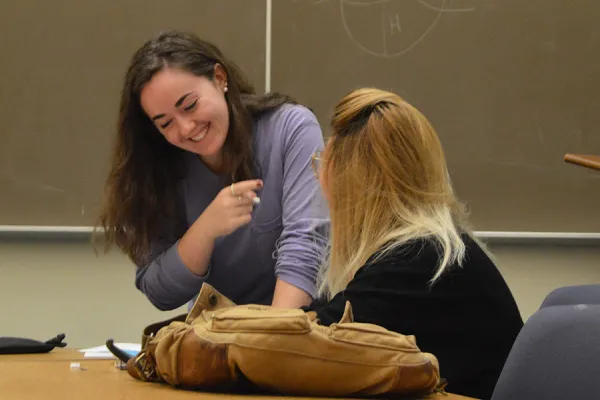Calculus Training Groups Help Students Persist in STEM
Research & Inquiry

Published November 9, 2017
Alina Siminiouk ’20 says the Smith students she is tutoring in calculus are convinced she has always been good at math.
That’s not so, says Siminiouk—a Smith Posse scholar and one of seven peer mentors paired with students in introductory calculus classes this fall. She struggled with the subject in high school and worried about how she would handle calculus at Smith. Siminiouk credits a calculus training group she signed up for in her first semester with helping her gain assurance about her skills.
“I’ve never felt more confident about calculus than I do now,” says Siminiouk, an engineering major who is leading her own training group this semester. “The program turned me from someone who was math-averse to someone who was considering a math major.”
The calculus training groups (CTGs) are designed to help students who are interested in STEM studies but may lack adequate math preparation. That’s a challenge that goes beyond Smith—national studies show only about a third of U.S. high school seniors are prepared for college-level math.
At Smith, “calculus is required in nine out of 10 of our science majors,” notes Jennifer Beichman, a lecturer in mathematics and statistics who—along with her husband and fellow lecturer, Daniel Schultheis—is helping to revamp the college’s introductory math curriculum.
“The calculus training groups were inspired by a model we’ve seen work at other colleges,” Beichman says. “At Smith, we have amazing students who are interested in the kind of peer-to-peer learning that can help their classmates persist.”
The four-person training groups meet for an hour each week outside of class to review assignments and practice calculus skills. Peer mentors, who are paid for their time, also meet weekly with Beichman and Schultheis to plan group study activities for the CTGs.
Interest in the program is growing, Beichman says. The number of students applying to join a calculus training group rose from 44 in 2016—the year the model launched—to 65 this fall. Currently, 28 students are participating in seven peer-led training groups, and the math department hopes to increase the number of tutors in future semesters.
One of Siminiouk’s recent training sessions began with a student requesting help with a homework assignment on differential equations.
“Any thoughts from the room on how we are going to solve this?” Siminiouk asked the group. “Let’s take a step back and think about this.”
After collectively breaking down the steps needed to solve the equation, even those students who’d initially described themselves as lost were satisfied that they understood the math.
“I saw that light bulb go off!” Siminiouk said to one student, as they shared a high five.
Peer mentor Samantha Comeau ’18 says the training group model works because it provides a setting where students can get to know each other and feel comfortable asking questions.
“It’s the personal connections that matter,” says Comeau, a math and education major who plans to pursue a career in teaching after she graduates. “It feels more like a support group, where students can vent to each other.”
Kristine Lu ’21 says her calculus training group has already had a positive impact on her first few months at Smith. “I’m not that strong at calculus, so it’s been really helpful,” she says. “The training is something I really wanted to do.”
Physics professor Gary Felder—who leads a teaching circle on math readiness at the Sherrerd Center for Teaching and Learning—says the calculus training groups will help ensure student success across the sciences at Smith.
“Ninety percent of the time, if a student is having trouble in introductory physics, it’s because of their background in math,” he says. “What we want to avoid is having people drop out of the pipeline because they are getting Cs in an introductory course.”
The training group model coincides with a new math assessment tool the college is using to help direct more first-year students to support services, Felder says. The teaching circle is collecting data on the effectiveness of both strategies with an eye to securing grant funding to expand the calculus training groups and other supports for students.
In addition to serving students who need more grounding in math, the training groups help bolster the skills of peer tutors, Felder says, noting that “the way you really learn something is to teach it.”
Calculus training group leader Samantha Comeau '18, helps Dayana Meza '21 solve an equation. Photo by Maryellen Stohlman-Vanderveen '19.